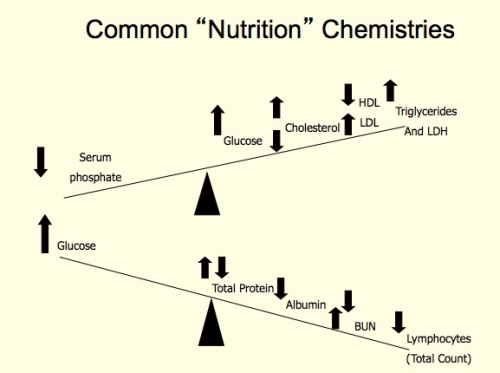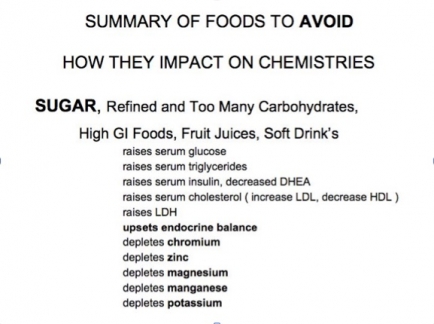Why Decayed Teeth
A Mouth full of Evidence of.. Systemic decline
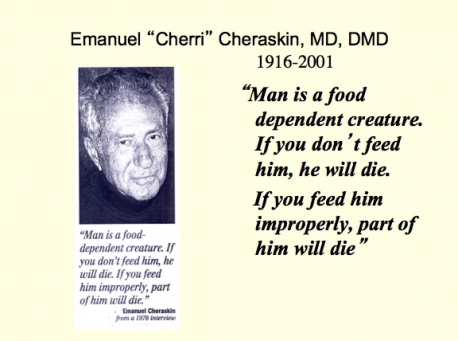
Disease rarely, if ever, just ‘happens’. Rather, disease is preceded by a metabolic or physiological dysfunction. These imbalances emerge slowly and progress continuously, but generally are not noticeable because our bodies work very hard at accommodating the imbalances.
Simply put, when your chemistry is in balance, you have resistance to disease. When it is out of balance, you have susceptibility to disease that shows up first in the mouth in the form of dental decay and gum disease – “a mouth full of evidence of where you have been, where you are at and where you are heading”.
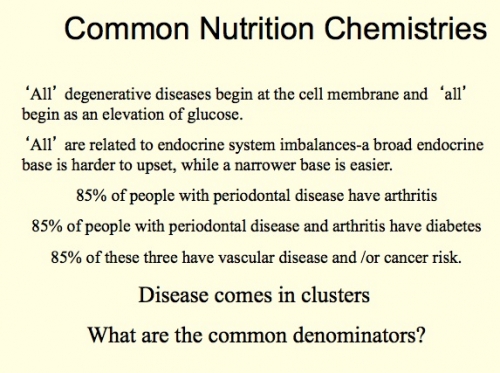
Patients who are diligent with their homecare get easily frustrated when they are told they have dental decay. Through their frustration they ask what does it take to be cavity free? Is proper brushing and flossing the solution, and/or will limiting sticky sugary snacks stop this problem? Some patients just feel doomed to constant dental work due to hereditary factors and the soft teeth that were handed to them from their parents. All of these concepts are based upon a long held belief that tooth decay is a result of the fermentation process of plaque bacteria that eats away on a tooth.
External factors that influence dental decay include bacteria, food in the mouth, how the teeth fit next to each other, anxiety or medications or caffeine that affect saliva flow and other natural protective measures....
Another paradigm that has been around for many years that unfortunately does not get equal consideration, is the research of Dr Ralph Steinman.
- “Decay is a systemic disease” decay comes from within, not from without. Certainly, local factors play a role, but they are not the initiating factors in dental decay.
Internal factors that resist decay include heredity, hardness of the tooth, the foods we eat, hormones, vitamins, minerals, metabolic shields and the fluid transport through the teeth.....
Teeth are not solid, but consist of a series of dentin tubules and parallel enamel roads. The tooth has to be considered as an organ, like the liver or kidney, before we can totally understand how to cope with the problem of decay. The three basic divisions of the tooth (enamel, dentin and pulp chamber) all mutually depend on each other, and fluids from one part pass to the other parts. Dr. Steinman proved that substances moved from within the body through the tooth and into the mouth. He did this by injecting a radioactive dye into the gut of rats and found that it took only 6 minutes for his dye to make its way into the tooth. He proposed that this movement of the dye is associated with normal flushing that occurs constantly in a tooth to provide essential nutrients, and prevent bacteria from causing damage to the tooth. This movement within the tooth is called dentinal fluid transport. Dr Steinman also worked with an endocrinologist John Leonora to search for a hormonal source for regulating the dentinal fluid transport. They found the mechanism was regulated by the hypothalamus, a structure within the brain responsible for a large number of normal functions throughout the body, including regulating sleep, temperature, eating, and sexual development. The hypothalamus also regulates the functions of the pituitary gland by directing the pituitary to stop or start production of its hormones.
Their collaborative studies led to the discovery of a new endocrine system: the hypothalamic-parotid gland endocrine axis. The parotid gland is a major salivary gland located on either side of the cheeks within our mouth, and is the only salivary gland that communicates to the hypothalamus. This communication occurs with the parotid releasing factor and these researchers were able to isolate this hormone in a pure form, and showed that it stimulates dentinal fluid flow. They demonstrated that a high sugar diet suppresses the function of this endocrine axis and consequently dentinal fluid flow. They went on to demonstrate in rats that they could physiologically prevent the suppressive effect of the high sugar diet on dentinal fluid flow and prevent dental decay 80 to 100 percent of the time. Dr Steinman discovered that when the dentinal fluid flow is flowing from inside the tooth outwards, the teeth are very resistant to decay. However, when the fluid flow isn’t flowing from inside out and in fact reverses and flows from the surface of the tooth to the inner portion of each tooth, decay sets in very quickly.
- Current diet plays an overpowering role here and supersedes hereditary predispositions. Foods can influence the activities of the endocrine system. Fluid moves from the pulp chamber through the dentin, through the enamel into the mouth. This fluid is similar to fluids found between the cells in the rest of the body, and by altering the function of the endocrine glands, that fluid flow could be reversed such that the tooth "sucked" bacteria, acids and other things from the mouth into the tooth.
- By simply changing the diet the direction of the fluid flow could be altered, and the endocrine system influenced.
- We have found many foods that stimulate it to flow outward (which is optimum).
- Most of the ‘flow-in’ (decay-producing) foods are the refined foods, as you might expect. Sugar, refined flour and convenience foods are the biggest influence favouring dental decay.
- Generally speaking a diet adequate in protein, controlled in carbohydrate, rich in natural fats favour the tooth’s defence against decay. That is Whole nutrient dense foods.
- Fluoride to a point may make the teeth enamel harder, but the hardness of the enamel has no relationship to resistance to decay.
- About 2 to 3 years of age the permanent teeth are forming within the jawbone. If there is a deficiency of vitamin C, D, K2 or A during calcification, a tooth less resistant to decay will be produced.
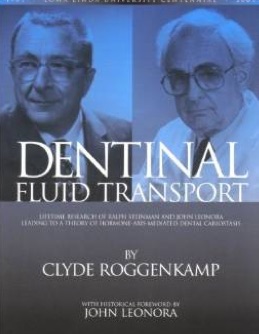
The systemic theory of dental caries…
Nevertheless consider the following …..The health problem that affects more children today than any other is dental decay. It is estimated that 95% of our children today have active dental decay, yet dental decay was rare in most primitive tribes, following their traditional diets. Dr Price observations found only one cavity per 1000 teeth in skulls.
In his research into tooth decay Weston Price discovered that a diet high in fat-soluble vitamins, fats (especially butterfat ) and minerals could enhance the health of malnourished children, and even halt the progress of tooth decay.
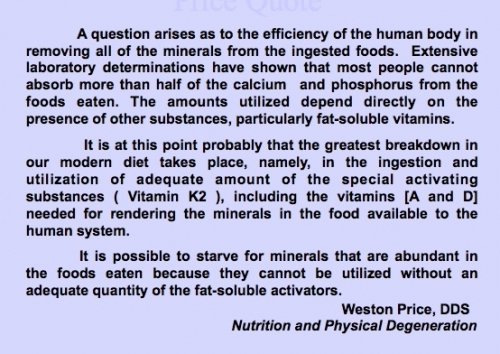
Consumption of fats and adequate protein helps with the absorption of minerals and fat-soluble vitamins, such as vitamins A, D, and K2, essential to good tooth and bone health. There is a Synergy of K2, A and D.
He treated a group of malnourished children from an orphanage with a diet of butter, cod-liver oil, rich meat and vegetable stews (with the bones included) and seafood chowders (prepared with the fish bones and organs) along with fermented foods such as sauerkraut and cultured dairy products. The amount of sugar in the diet was eliminated and raw dairy products and animal proteins increased. Decay in their teeth was arrested and their teeth began to remineralize. New decay was prevented and their general health improved. Dr Price says we can reverse physical degeneration by adhering to age-old principles. As complex as dental decay is scientifically, it boils down to simplicity when we look at the cause and cure. We are the masters of our fate.
Balancing Body Chemistries requires us to eat for a purpose not just pleasure — so emphasis needs to be given in certain directions once an imbalance is present.
When looking at chemistries we need to interpret them in light of the fact that the body is always striving to win, and it isn't an indication of failure but an accommodation of survival.
When looking at chemistry markers it is never wise to look at them in isolation but in respect to the movement of many markers that are compensatory in response to gaining homeostasis.
We often find in patients with recurrent tooth decay, "gum disease" and nearly all other health challenges there is a "measurable" poor protein status, mineral / iron status and blood glucose instability problems.
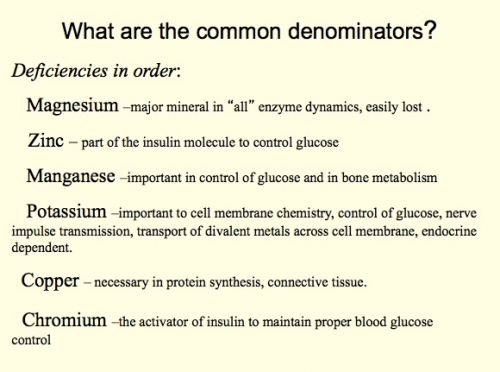
When reviewing and measuring an individual's Body Chemistry what follows are the most common findings.
There are six basic blood tests that respond when we consume sugar and caffeine. They are calcium, phosphorous, glucose, cholesterol, triglycerides, and uric acid.
Calcium is elevated relative to phosphate. Result: Calcium can precipitate out of the blood and do damage where it deposits.
Phosphorous is lowered. Result: You are more susceptible to dental decay and other degenerative diseases.
Glucose is elevated. Result: This creates the potential for diabetes and heart disease, and is step one toward most degenerative diseases.
Triglycerides are elevated. Result: This is seen as low-density lipoproteins and increases your risk of heart attack via a clot. Usually the HDL is low
Uric Acid is elevated. Result: Cause or effect? This condition is found in people with heart disease, arthritis, gum disease and other degenerative diseases.
